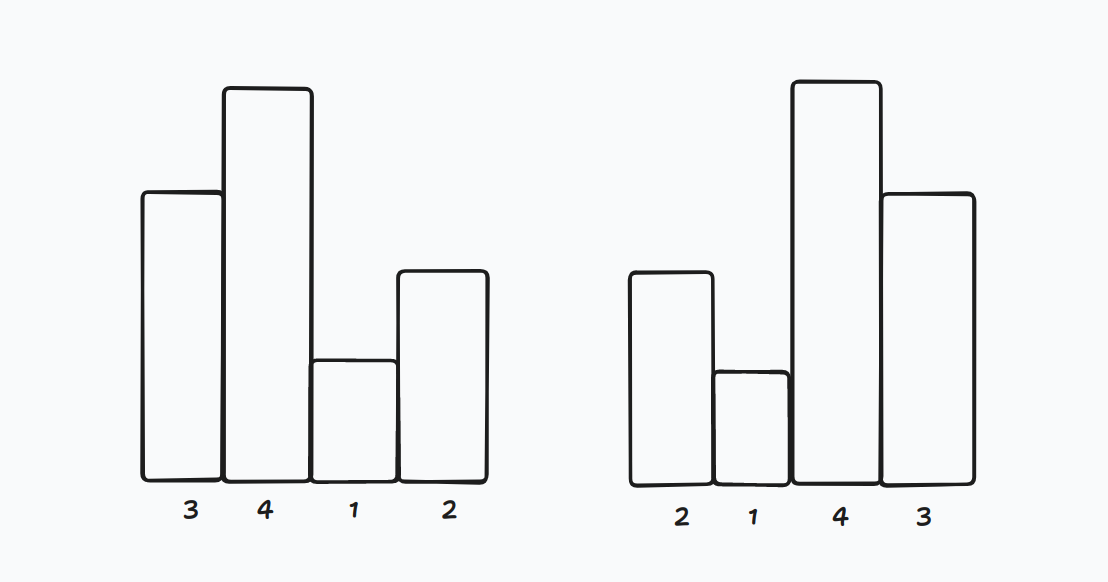CF1693D--单调区间
\(T_4\) 单调区间结题报告
题目描述
一句话题意:给定一个排列 \(a\) 算出有多少个区间 \([l , r]\) , 满足其可以划分为一个单调递增子序列和单调递减子序列,其中单调递增子序列长度 \(\ge 1\) , 单调递减子序列长度可为 \(0\) . \(n \le 10 ^ 5\)
题解
呃呃能自己想出来挺不容易的,废了老子一下午一晚上。
感觉大家在证分治做法的复杂度,我也不淌这潭浑水了,本做法为 \(n \log n\) , 使用树状数组和优先队列数据结构。
首先考虑一个结论,对于一个不满足条件的区间 \([a , b]\) ,其一定满足如下条件:
对于 \(a \le i < j < k < l \le b\) , 满足:
\[a_k < a_l < a_i < a_j \ \lor \ a_j < a_i < a_l < a_k \ \ \ \ \ \ \ \ \ \ \ (1) \]
手模一下就能发现这样构成不了合法解。
两个图:(图是反的)
我们又发现假设我们目前为 \(l\) , 那么对于上面的结论来说,去找最大满足上述结论的 \(\max\{i\}\) .
那么 \(l\) 贡献出的答案为 $$l - \max{i}$$
当然,我们称 \(\max\{i\}\) 为 \(l\) 的左端点 \(L_l\)
对于 \(\alpha < l\) , 那么 \([i , l] \ \left(i \le L_{\alpha}\right)\) 区间同样取不到。
于是得到进阶结论:
对于排列 \(a\) : ( \(L\) 定义不变 )
\[ans = \sum_{i = 1}^{n} i - \max_{1 \le j \le i}\{L_j\} \ \ \ \ \ \ \ \ \ \ (2) \]
然后我们考虑去求 \(L_i\)
我们对于结论 \(1\) 来说,可以分成或左或右两方分讨。
对于一种情况来说 (假设为第一种) , 设目前为 \(d\) .
让目前那四个数为 \(a , b , c , d\)
一个显然的结论:
我们如果为了让 \(L_d\) 最小,\(c\) 一定是离 \(d\) 最近,且 \(a_c > a_d\) 的点。
贪心显然
于是我们可以去枚举 \(c\) , 以 \(c\) 为下标存储 \(d\) .
那我们求 \(L_d\) 时 , 显然是某个 \(1 \le i < c\) , 且 \(i\) 满足 \(a_i < a_d \ \land \ \exists \ j : i < j < c , a_j < a_i\) .
其实无脑一下就是上图中(后面的图) 最后一个大于第一个,第一个大于第二个,找下标最大的第一个。
所以可以开一个树状数组,就是以 \(a_i\) 为下标,维护 \(i\) .
(有人有疑惑为什么不从图中第二个位置转移吗? 那样看起来还好处理一点)
错误点在于第二个点要从比他大的转移来,然而比他大的怎么就一定比 \(a_d\) 小呢?
例子: \(3 , 100 , 2 , 1000 , 5\)
如果你从 你按你的想法查 \(2\) , 查出来的位置是 \(2\) . 不合法。
因此需要算,如果存在一个比 \(a_i\) 小的数刚刚加进来,就可以把 \(i\) ,扔进树状数组了。
具体可以用一个大根堆,在枚举 \(c\) ,并处理完 \(d\) 后,将所有在优先队列中大于 \(a_c\) 的数加进树状数组(此时的 \(c\) 就是后面某次的 \(b\) 啊!) 差的时候查 \([1 , a_i)\) 中下标最大值 (显然是插进树状数组中的的才可以转移)。
对于第一个图,处理差不多,不再赘述。
然而就是说第一个图,要求 \(\max\limits_{i < j \le n}\{val_j\}\)
( \(val\) 是树状数组维护的值 )
即后缀和。我们只需要把输转数组反过来存, \(n - i + 1\) 存 \(i\) .
\(Code\)
CODE
#include <bits/stdc++.h>
#include <bits/extc++.h>
#define int long long
#ifdef linux
#define getchar getchar_unlocked
#endif
using namespace std ;
using namespace __gnu_pbds ;
using namespace __gnu_cxx ;
typedef long long ll ;
const int N = 4e5 + 100 ;
inline int read() {
int x = 0 , f = 1 ;
char c = getchar() ;
while (c < '0' || c > '9') {
if (c == '-') f = -f ;
c = getchar() ;
}
while (c >= '0' && c <= '9') {
x = x * 10 + c - '0' ;
c = getchar() ;
}
return x * f ;
}
int n ; int a[N] ; int Ans[N] ;
struct Binary_Index_Array_Max {
#define lowbit(x) (x & (- x))
int t[N] ;
void clear() {
memset(t , 0 , sizeof(t)) ;
}
void add(int pos , int val) {
while (pos <= n) {
t[pos] = max(t[pos] , val) ;
pos += lowbit(pos) ;
}
}
int Query(int pos) {
int ans = 0 ;
while (pos > 0) {
ans = max(t[pos] , ans) ;
pos -= lowbit(pos) ;
}
return ans ;
}
} t1 , t2 ;
int front1[N] , front2[N] ;
vector <int> v1[N] , v2[N] ;
__gnu_pbds :: priority_queue <int , less<int> > q1 ;
__gnu_pbds :: priority_queue <int , greater<int> > q2 ;
int pos[N] ;
signed main() {
n = read() ;
for (int i = 1 ; i <= n ; ++ i) a[i] = read() , pos[a[i]] = i ;
for (int i = 1 ; i <= n ; ++ i) {
front1[i] = t1.Query(n - a[i] + 1) ; v1[front1[i]].push_back(i) ;
front2[i] = t2.Query(a[i]) ; v2[front2[i]].push_back(i) ;
t1.add(n - a[i] + 1 , i) ; t2.add(a[i] , i) ;
} t1.clear() ;
for (int i = 1 ; i <= n ; ++ i) {
for (auto j : v1[i]) {
Ans[j] = t1.Query(a[j] - 1) ;
}
while (!q1.empty()) {
int x = q1.top() ;
if (x <= a[i]) break ; q1.pop() ;
t1.add(x , pos[x]) ;
} q1.push(a[i]) ;
} t1.clear() ;
for (int i = 1 ; i <= n ; ++ i) {
for (auto j : v2[i]) {
Ans[j] = max(Ans[j] , t1.Query(n - (a[j] + 1) + 1)) ;
}
while (!q2.empty()) {
int x = q2.top() ;
if (x >= a[i]) break ; q2.pop() ;
t1.add(n - x + 1 , pos[x]) ;
} q2.push(a[i]) ;
}
int Ansp = 0 ;
for (int i = 1 ; i <= n ; ++ i) {
Ans[i] = max(Ans[i] , Ans[i - 1]) ;
Ansp += i - Ans[i] ;
}
cout << Ansp << '\n' ;
}




【推荐】国内首个AI IDE,深度理解中文开发场景,立即下载体验Trae
【推荐】编程新体验,更懂你的AI,立即体验豆包MarsCode编程助手
【推荐】抖音旗下AI助手豆包,你的智能百科全书,全免费不限次数
【推荐】轻量又高性能的 SSH 工具 IShell:AI 加持,快人一步
· 地球OL攻略 —— 某应届生求职总结
· 周边上新:园子的第一款马克杯温暖上架
· Open-Sora 2.0 重磅开源!
· 提示词工程——AI应用必不可少的技术
· .NET周刊【3月第1期 2025-03-02】